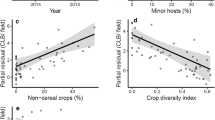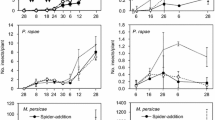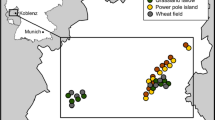Abstract
Context
Plant diversity can sometimes determine the distribution of pests in ecosystems, but the effects of plant diversity at local and landscape scales on the occurrence of pests on novel marginal hosts are still unknown.
Objectives
We explored the direct effects of plant diversity at local and landscape scales on the colonization of the marginal host walnut by Helicoverpa armigera (Lepidoptera: Noctuidae).
Methods
We surveyed and compared the occurrence (and damage) of H. armigera in walnut orchards embedded in simple vs. diverse landscapes, and with weeds or without weed cover. The surrounding landscape composition and weed communities in walnut orchards were also investigated to shed light on the mechanisms driving H. armigera responses.
Results
Diverse landscapes were associated with lower densities of overwintering adult H. armigera, first generation eggs and larvae, as well as with lower infestation rates of walnut fruits. Weed presence in walnut orchards had no significant effects on the abundance of H. armigera adults or eggs, but was associated with higher larvae densities in orchards, in both simple and diverse landscapes. The effect of within-orchard weed cover on larvae was stronger in diverse landscapes.
Conclusions
Our study demonstrated that landscape composition coupled with local orchard ground cover vegetation mediated the occurrence of H. armigera on a marginal host walnut. Monoculture production increases walnut’s exposure to the pest and may accelerate its evolutionary adaptation to this poor host; weed cover in individual orchards may increase larval density by providing floral resources for adults.





Similar content being viewed by others
References
Andow DA (1991) Vegetational diversity and arthropod population response. Annu Rev Entomol 36:561–586
Bao X, Zheng F, Cai M, Wu J (2010) Effects of complementary nutrients on adult’s reproduction and longevity of oriental fruit moth, Grapholitha molesta Busck. J Northwest A & F Univ 38:119–123 (in Chinese)
Batary P, Baldi A, Kleijn D, Tscharntke T (2011) Landscape-moderated biodiversity effects of agri-environmental management: a meta-analysis. P Roy Soc B Biol Sci 278:1894–1902
Bates D, Maechler M, Bolker B, Walker S (2015) Fitting linear mixed-effects models using lme4. J Stat Softw 67:1–48
Beaumelle L, Auriol A, Grasset M, Pavy A, Thiéry D, Rusch A (2021) Benefits of increased cover crop diversity for predators and biological pest control depend on the landscape context. Ecol Solut Evid 2:e12086
Bernays EA, Bright KL, Gonzalez N, Angel J (1994) Dietary mixing in a generalist herbivore: tests of two hypotheses. Ecology 75:1997–2006
Berthelot S, Frühbrodt T, Hajek P, Nock CA, Dormann CF, Bauhus J, Fründ J (2021) Tree diversity reduces the risk of bark beetle infestation for preferred conifer species, but increases the risk for less preferred hosts. J Ecol 109:2649–2661
Bischoff A, Pollier A, Lamarre E, Salvadori O, Cortesero AM, Le Ralec A, Tricault Y, Jaloux B (2016) Effects of spontaneous field margin vegetation and surrounding landscape on Brassica oleracea crop herbivory. Agric Ecosyst Environ 223:135–143
Bivand RS, Wong DWS (2018) Comparing implementations of global and local indicators of spatial association. TEST 27:716–748
Boetzl FA, Schuele M, Krauss J, Steffan-Dewenter I, Marini L (2020) Pest control potential of adjacent agri-environment schemes varies with crop type and is shaped by landscape context and within-field position. J Appl Ecol 57:1482–1493
Brezzi M, Schmid B, Niklaus PA, Schuldt A (2017) Tree diversity increases levels of herbivore damage in a subtropical forest canopy: evidence for dietary mixing by arthropods? J Plant Ecol 10:13–27
Carrière Y, Goodell PB, Ellers-Kirk C, Larocque G, Dutilleul P, Naranjo SE, Ellsworth PC (2012) Effects of local and landscape factors on population dynamics of a cotton pest. PLoS ONE 7:e39862
Forister ML, McCall AC, Sanders NJ, Fordyce JA, Thorne JH, O’Brien J, Waetjen DP, Shapiro AM (2010) Compounded effects of climate change and habitat alteration shift patterns of butterfly diversity. P Natl Acad Sci USA 107:2088–2092
Gilabert A, Gauffre B, Parisey N, Le Gallic JF, Lhomme P, Bretagnolle V, Dedryver CA, Baudry J, Plantegenest M (2016) Influence of the surrounding landscape on the colonization rate of cereal aphids and phytovirus transmission in autumn. J Pest Sci 90:447–457
Goethe JK, Dorman SJ, Huseth AS (2021) Local and landscape scale drivers of Euschistus servus and Lygus lineolaris in North Carolina small grain agroecosystems. Agric For Entomol 23:441–451
Grab H, Poveda K, Danforth B, Loeb G (2018) Landscape context shifts the balance of costs and benefits from wildflower borders on multiple ecosystem services. P Roy Soc B Biol Sci 285:20181102
Grundy PR, Sequeira RV, Short KS (2004) Evaluating legume species as alternative trap crops to chickpea for management of Helicoverpa spp. (Lepidoptera: Noctuidae) in central Queensland cotton cropping systems. B Entomol Res 94:481–486
Guo Y (1998) Studies on cotton bollworm. China Agriculture Press, Beijing (in Chinese)
Hagler JR, Thompson AL, Machtley SA, Casey MT (2021) Arthropod demography, distribution, and dispersion in a novel trap-cropped cotton agroecosystem. J Insect Sci 21:20
Haile G, Lemenih M, Senbeta F, Itanna F (2016) Plant diversity and determinant factors across smallholder agricultural management units in Central Ethiopia. Agroforest Syst 91:677–695
Hatt S, Boeraeve F, Artru S, Dufrêne M, Francis F (2018) Spatial diversification of agroecosystems to enhance biological control and other regulating services: An agroecological perspective. Sci Total Environ 621:600–611
He C, Shen D, Zhang R, Yin L, Yuan S, Tian X (2020) Effects of supplementary nutrition on adult longevity and reproduction of Assara inouei Yamanaka. Acta Agric Boreali Occident Sin 29:135–142 (in Chinese)
Jactel H, Moreira X, Castagneyrol B (2021) Tree diversity and forest resistance to insect pests: patterns, mechanisms, and prospects. Annu Rev Entomol 66:277–296
Jahner JP, Bonilla MM, Badik KJ, Shapiro AM, Forister ML (2011) Use of exotic hosts by Lepidoptera: widespread species colonize more novel hosts. Evolution 65:2719–2724
Jones CM, Parry H, Tay WT, Reynolds DR, Chapman JW (2019) Movement ecology of pest Helicoverpa: implications for ongoing spread. Annu Rev Entomol 64:277–295
Kennedy GG, Storer NP (2000) Life systems of polyphagous arthropod pests in temporally unstable cropping systems. Annu Rev Entomol 45:467–493
Koh I, Holland JD (2015) Grassland plantings and landscape natural areas both influence insect natural enemies. Agric Ecosyst Environ 199:190–199
Koricheva J, Vehviläinen H, Riihimäki J, Ruohomäki K, Kaitaniemi P, Ranta H (2006) Diversification of tree stands as a means to manage pests and diseases in boreal forests: myth or reality? Can J Forest Res 36:324–336
Lefcheck JS, Whalen MA, Davenport TM, Stone JP, Duffy JE (2013) Physiological effects of diet mixing on consumer fitness: a meta-analysis. Ecology 94:565–572
Lehmann P, Ammunét T, Barton M, Battisti A, Eigenbrode SD, Jepsen JU, Kalinkat G, Neuvonen S, Niemelä P, Terblanche JS, Økland B, Björkman C (2020) Complex responses of global insect pests to climate warming. Front Ecol Environ 18:141–150
Letourneau DK, Armbrecht I, Rivera BS, Lerma JM, Carmona EJ, Daza MC, Escobar S, Galindo V, Gutiérrez C, López SD (2011) Does plant diversity benefit agroecosystems? A synthetic review. Ecol Appl 21:9–21
Li H, Li J, Yang L, Liu J, Lu Y (2017) Helicoverpa armigera infest walnut: a preliminary investigation reportion. China Plant Prot 37:44–45 (in Chinese)
Li H, Li Q, Wang D, Liu J, Zhang J, Lu Y (2020a) Effect of a cotton intercrop on spider mite populations in jujube trees. J Asia-Pac Entomol 23:167–171
Li M, Yang L, Pan Y, Zhang Q, Yuan H, Lu Y (2020b) Landscape effects on the abundance of Apolygus lucorum in cotton fields. Insects 11:185
Liu H (2021) Occurrence of Helicoverpa armigera in walnut orchard in south Xinjiang, and its behavioral selection of adults, feeding adaptability of larvae. Master Thesis, Chinese Academy of Agricultural Sciences (China) (in Chinese)
Lu Z, Baker G (2013) Spatial and temporal dynamics of Helicoverpa armigera (Lepidoptera, Noctuidae) in contrasting agricultural landscapes in northwestern China. Int J Pest Manag 59:25–34
Lu Z, Pan W, Zhang X, Li X, Zhang J (2012) The effect of cropping landscapes on the population dynamics of the cotton bollworm Helicoverpa armigera (Lepidoptera, Noctuidae) in the northern Xinjiang. Acta Ecol Sin 32:7925–7931 (in Chinese)
Lu Y, Jiang Y, Liu J, Zeng J, Yang X, Wu K (2018) Adjustment of cropping structure increases the risk of cotton bollworm outbreaks in China. Chin J Appl Entomol 55:19–24 (in Chinese)
Lu Y, Wyckhuys KAG, Yang L, Liu B, Zeng J, Jiang Y, Desneux N, Zhang W, Wu K (2021) Bt cotton area contraction drives regional pest resurgence, crop loss and pesticide use. Plant Biotechnol J. https://doi.org/10.1111/pbi.13721
Meisner MH, Zaviezo T, Rosenheim JA (2017) Landscape crop composition effects on cotton yield, Lygus hesperus densities and pesticide use. Pest Manag Sci 73:232–239
Messina FJ, Durham SL (2013) Adaptation to a novel host by a seed beetle (Coleoptera: Chrysomelidae: Bruchinae): effect of source population. Environ Entomol 42:733–742
Messina FJ, Lish AM, Gompert Z (2018) Variable responses to novel hosts by populations of the seed beetle Callosobruchus maculatus (Coleoptera: Chrysomelidae: Bruchinae). Environ Entomol 47:1194–1202
Messina FJ, Lish AM, Springer A, Gompert Z (2020) Colonization of marginal host plants by seed beetles (Coleoptera: Chrysomelidae): effects of geographic source and genetic admixture. Environ Entomol 49:938–946
Montagnana PC, Alves RSC, Garófalo CA, Ribeiro MC (2021) Landscape heterogeneity and forest cover shape cavity-nesting hymenopteran communities in a multi-scale perspective. Basic Appl Ecol 56:239–249
Oksanen J, Blanchet FG, Friendly M, Kindt R, Legendre P, McGlinn D, Wagner H (2018) Vegan: community ecology package. R package version 2.4-6. https://CRAN.R-project.org/package=vegan.
Orr HA, Unckless RL (2014) The population genetics of evolutionary rescue. PLoS Genet 10:e1004551
Otway SJ, Hector A, Lawton JH (2005) Resource dilution effects on specialist insect herbivores in a grassland biodiversity experiment. J Anim Ecol 74:234–240
Pan H, Tena A, Xiu C, Liu B, Lu Y, Desneux N (2019) Floral feeding increases diet breadth in a polyphagous mirid. J Pest Sci 92:1089–1100
Parry HR, Paull CA, Zalucki MP, Ives AR, Hulthen A, Schellhorn NA (2017) Estimating the landscape distribution of eggs by Helicoverpa spp, with implications for Bt resistance management. Ecol Model 365:129–140
Parsa S, Ccanto R, Rosenheim JA (2011) Resource concentration dilutes a key pest in indigenous potato agriculture. Ecol Appl 21:539–546
Pöykkö H (2006) Females and larvae of a geometrid moth, Cleorodes lichenaria, prefer a lichen host that assures shortest larval period. Environ Entomol 35:1669–1676
Price TN, Leonard A, Lancaster LT (2017) Warp-speed adaptation to novel hosts after 300 generations of enforced dietary specialisation in the seed beetle Callosobruchus maculatus (Coleoptera: Chrysomelidae: Bruchinae). Eur J Entomol 114:257–266
R Core Team (2019) R: a language and environment for statistical computing. R Foundation for Statistical Computing, Vienna
Rajesh KM, Sinu PA, Nasser M (2021) Eleocharis dulcis (Burm.f) as a promising trap plant for the biocontrol of rice white stem borer, Scirpophaga innotata (Walker). Biol Control 160:104676
Santoiemma G, Mori N, Tonina L, Marini L (2018) Semi-natural habitats boost Drosophila suzukii populations and crop damage in sweet cherry. Agric Ecosyst Environ 257:152–158
Schellhorn N, Bianchi F, Hsu C (2014) Movement of entomophagous arthropods in agricultural landscapes: links to pest suppression. Annu Rev Entomol 59:559–581
Schiebe C, Blaženec M, Jakuš R, Unelius CR, Schlyter F (2011) Semiochemical diversity diverts bark beetle attacks from Norway spruce edges. J Appl Entomol 135:726–737
Sivakoff FS, Rosenheim JA, Dutilleul P, Carrière Y (2013) Influence of the surrounding landscape on crop colonization by a polyphagous insect pest. Entomol Exp Appl 149:11–21
Takada MB, Yoshioka A, Takagi S, Iwabuchi S, Washitani I (2012) Multiple spatial scale factors affecting mirid bug abundance and damage level in organic rice paddies. Biol Control 60:169–174
Tillman PG, Mullinix BG Jr. (2004) Grain sorghum as a trap crop for corn earworm (Lepidoptera: Noctuidae) in Cotton. Environ Entomol 33:1371–1380
Tsafack N, Alignier A, Head GP, Kim JH, Goulard M, Menozzi P, Ouin A (2016) Landscape effects on the abundance and larval diet of the polyphagous pest Helicoverpa armigera in cotton fields in North Benin. Pest Manag Sci 72:1613–1626
Tscharntke T, Tylianakis JM, Rand TA, Didham RK, Fahrig L, Batáry P, Bengtsson J, Clough Y, Crist TO, Dormann CF, Ewers RM, Fründ J, Holt RD, Holzschuh A, Klein AM, Kleijn D, Kremen C, Landis DA, Laurance W, Lindenmayer D, Scherber C, Sodhi N, Steffan-Dewenter I, Thies C, van der Putten WH, Westphal C (2012) Landscape moderation of biodiversity patterns and processes—eight hypotheses. Biol Rev 87:661–685
Ulmer R, Couty A, Eslin P, Gabola F, Chabrerie O (2020) The firethorn (Pyracantha coccinea), a promising dead-end trap plant for the biological control of the spotted-wing Drosophila (Drosophila suzukii). Biol Control 150:104345
Villa M, Marrão R, Mexia A, Bento A, Pereira JA (2016) Are wild flowers and insect honeydews potential food resources for adults of the olive moth, Prays oleae? J Pest Sci 90:185–194
Xu H, Turlings TCJ (2018) Plant volatiles as mate-finding cues for insects. Trends Plant Sci 23:100–111
Yang L, Liu B, Zhang Q, Zeng Y, Pan Y, Li M, Lu Y (2019) Landscape structure alters the abundance and species composition of early-season aphid populations in wheat fields. Agric Ecosyst Environ 269:167–173
Yang FY, Chen JH, Ruan QQ, Wang BB, Jiao L, Qiao QX, He WY, You MS (2021) Fitness comparison of Plutella xylostella on original and marginal hosts using age-stage, two-sex life tables. Ecol Evol 11:9765–9775
Acknowledgements
We thank Kaitao Wang, Hainuo Wang, Hao Li and Bowen Song for their contribution to the fieldwork. This study was financially supported by the National Natural Science Funds of China (Grant No. U2003212 and 32060618).
Author information
Authors and Affiliations
Contributions
Y.L. conceived and designed the study. L.Y., H.L. (Haining Liu), Y.P., and H.L. (Haiqiang Li) performed the field surveys. L.Y. analyzed the data and wrote the first draft of the manuscript. All authors read and approved the manuscript.
Corresponding author
Ethics declarations
Conflict of interest
Authors declare that they have no conflict of interest.
Additional information
Publisher's Note
Springer Nature remains neutral with regard to jurisdictional claims in published maps and institutional affiliations.
Supplementary Information
Below is the link to the electronic supplementary material.
Rights and permissions
About this article
Cite this article
Yang, L., Liu, H., Pan, Y. et al. Landscape simplification increases the risk of infestation by the polyphagous pest Helicoverpa armigera for walnut, a novel marginal host. Landsc Ecol 37, 2451–2464 (2022). https://doi.org/10.1007/s10980-022-01486-w
Received:
Accepted:
Published:
Issue Date:
DOI: https://doi.org/10.1007/s10980-022-01486-w




